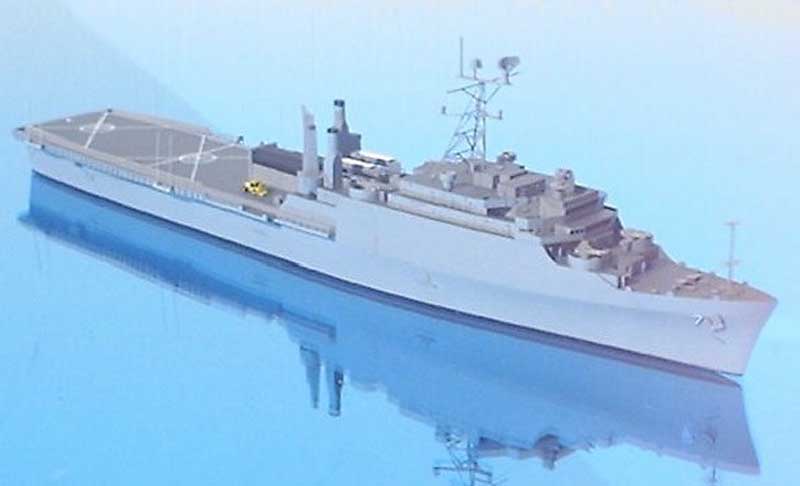
Reviewed by Jeff Hughes

| The United States Navy Austin Class LPD differs from the LSD in that it is intended to carry larger numbers of troops in lieu of vehicles and cargo. The class has a wet-well deck at the stern from which it can launch craft to carry troops, vehicles and cargo ashore. There is a helicopter pad that has two landing spaces. The ships are capable of accommodating up to 6 CH-46 and, according to the websites of some of the ships, 2 Av-8B Harriers can also operate from the ship if needed. LPD 4 does not have the small telescoping hanger that is fitted to the rest of the class. The hanger is only capable of storing one utility helicopter. The LPD relies on an accompanying LHD (Wasp Class) or LHA (Tarawa Class) for helicopters. | |
| LPD 7 to LPD 13 are fitted for flagship
duty and have one additional superstructure deck. LPD 11 was redesignated
AGF 11 in 1980 and acts as the flagship for the 3rd Fleet.
Builders:
Ship's Company: 420 (24 officers, 396 enlisted) |
|
| The kit comes in the distinctive JAG tube, and is well packed against breakage. Mine was so well packed I can't get all the parts back into the tube. The kit is molded in a light gray and mine has no pinholes except on the bottom of the hull. The kit is waterline and depicts the class as they where when launched (1965 to 1971). The extra superstructure deck (for the flagship version of this class) is provided to allow for building any of the class. Upon dry fitting the superstructure decks to the hull NO fit problems presented themselves. The deck and superstructure are loaded with details and they match pictures of the class from my reference material. | Click images
to enlarge |
| For those wishing to depict the ship in a diorama the stern is hollowed out somewhat but would need some work (there is no interior detail). There is very little clean up to be done on the hull. | |
| The superstructure decks, stacks, stern gate, telescoping hanger and the forklift are molded separately with very little clean up required. The rest of the small parts are molded in the familiar resin wafer form and will require minimal cleanup. Upon inspection of the smaller parts a great deal of detail is present. Two small pieces of styrene rod are provided, one for the mast and the other for the forward NTDS antenna. A small piece of 0.040-styrene strip is also provided to manufacture a walkway extension around the helicopter pads. The life raft racks could have used a little more detail as well as the telescoping hanger door. |  |
| The radar and railings on the PE fret are not as fine as some of the
other PE manufactures are able to make. There is not enough railing
to do the
entire ship you will need to purchase 1/700 scale deck railing from another source if you wish to add this to your model. It does have the main tripod mast, various mast platforms and boat cradles that will greatly enhance the look of the model. As seen in photos the tripod mast appears to be much 'finer' than standard surface warships and could only be duplicated with brass. |
|
| Now if PE could be made three-dimensional we would have something. For many of you the thought of using flat PE to depict a cylinder will be a problem, but at least the PE provides a template to make your own using small diameter brass rods. There is a small and very fixable problem with the SPS-10 radar. As it is laid out on the fret the base leg was omitted. This can easily be corrected with a small section of the PE or stretch sprue. | |
| The decals also allow the building of any of the class with all the
names and hull numbers. Helicopter markings are included, as are
flags and
various sizes of "E" awards to spruce up the model. |
|
|
|
|
| For those wishing to build a 1990's Austin Class LPD you
will need to remove the 3" guns, add CIWS on the bow and on the starboard
side of the superstructure. The starboard CIWS sits on a platform
that will need to be constructed. Be careful as some of the class
still had two sets of twin 3" guns installed as late as 1993. The
first two sets of guns where removed in the 1977-78 time frame. The
Mk 56 gun directors where removed during the late 1980's, once again reinforcing
the need to find a picture of the ship during the time frame you want to
model her in and follow it.
The kit scales out just about 6 feet too long and less than 1 foot too
short on the width. Not too shabby for resin and better than some
injection molded kits out there.
This kit retails for about $67.00 |
|
 Links
and References: Links
and References:
|
|